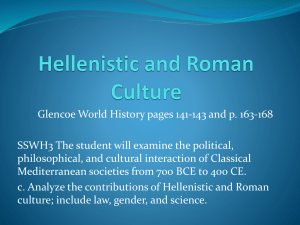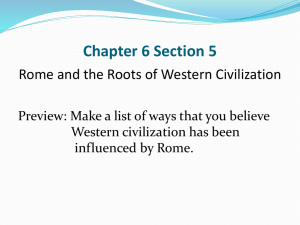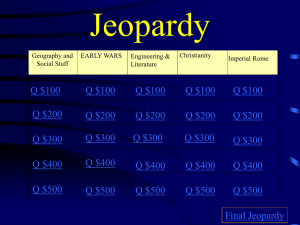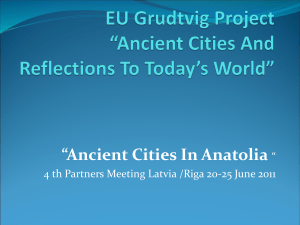Religion in Hellenistic and Roman Asia Minor
advertisement
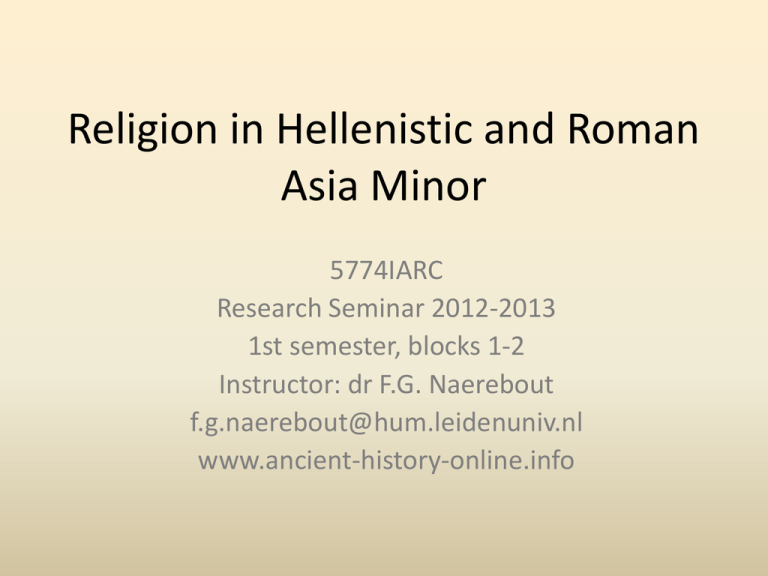
Religion in Hellenistic and Roman Asia Minor 5774IARC Research Seminar 2012-2013 1st semester, blocks 1-2 Instructor: dr F.G. Naerebout f.g.naerebout@hum.leidenuniv.nl www.ancient-history-online.info Schedule • • • • • • • • • • • • • • 13/9 Introduction I 20/9 Introduction II Assignment: General orientation: library, internet 27/9 Inventory Assignment: Draw up a list of possible subjects 4/10 NO CLASS 11/10 short presentations Assignment: Choose a subject & formulate a research question 18/10 short presentations Assignment: Choose a subject & formulate a research question 25/10 NO CLASS 1/11 Exemplary study 8/11 NO CLASS 15/11 short presentations Assignment: Select and discuss source 22/11 short presentations Assignment: Select and discuss source 29/11short presentations Assignment: Formulate your preliminary conclusions 6/12 short presentations Assignment: Formulate your preliminary conclusions 13/12 general discussion; conclusion Topography • L. Naim, Archaeological map of Western Anatolia, s.l. s.a. • W.M. Calder & G.E. Bean, A classical map of Asia Minor, London 1958 • W.M. Ramsay, The historical geography of Asia Minor, London 1890 • Barrington Atlas of the Greek and Roman World • NP Suppl 3: Historischer Atlas der antiken Welt • http://pleiades.stoa.org/ • Downloadable maps from Ramsay, op.cit.: http://www.elibron.com/maps Indicated in green: growing power of Rome in Asia Minor in 2nd/1st c BC Chronology • • • • • • • • • • • • • • • • • • • • • • 386 Anatolia under Persian rule again by King's Peace 363 The Satraps' Revolt 337 Kingdom of Pontus founded 334 Alexander crosses Dardanelles into Asia Minor. Persians defeated at the Granikos. Ionian cities liberated 334 Alexander conquers Lycia, Pamphylia and Pisidia 333 Alexander's conquests in Cilicia, decisive defeat of Persians at the battle of Issos 323 Alexander the Great dies at Babylon 323 The Temple of Artemis in Efesos completed after 125 years of construction 318 Antigonos takes over Asia Minor 308 Seleukos proclaimed king, the other diadochoi follow suit 301 Antigonos defeated and killed at the battle of Ipsos. Lusimachos rules Anatolia 300 Seleucid dynasty gains control in Syria. Antioch on the Orontes founded 295 Seleucids occupy Cilicia. Lusimachos conquers Ionia 281 Seleukos I defeats Lusimachos at the battle of Koroupedion. Lusimachos dies on the battlefield 280 Seleukos I murdered by Ptolemaios Keraunos at Lusimacheia. Bithynian, Cappadocian and Armenian kingdoms declare independence from Seleucid kingdom 278 Gauls invade Anatolia and settle in Central Anatolia 277 Antigonos Gonatas defeats the Celts at Lusimacheia 275 Gauls defeated by Seleucid king Antiochos I 263 – 241 Rise of Pergamon under the Attalid dynasty 230 Rome and Pergamon become allies. Gauls crushed by Pergamon 189 Antiochos III defeated by Romans at Magnesia 188 Treaty of Apameia puts an end to Seleucid rule in Anatolia • • • • • • • • • • • • • • • • • • • • • • • 133 Attalus III, the last king of Pergamon, dies and leaves his kingdom to Rome 130 Roman province of Asia established. Aristonikos defeated 120-63 Reign of Mithridates VI of Pontos 101 Cilicia becomes a Roman province 88 Mithridates has Roman citizens and Italians massacred 84 Lycia incorporated into the province of Asia 83 End of the Seleucid kingdom. The Mediterranean coast becomes a centre of piracy 81 Pontos annexed by Rome 80 The Commagene kingdom founded 78 Pompeius campaigns against pirates in Pamphylia, Cilicia and Isauria 74 Nicomedes IV, the king of Bithynia, dies and leaves his kingdom to Rome 67 Cilicia becomes a Roman province 66 Mithridates defeated by the Romans. He kills himself. Rome controls much of Anatolia 53 Crassus defeated by the Parthians at Harran 41 Anthony and Cleopatra meet at Tarsos 31 Cleopatra and Antony defeated by Octavian at the battle of Actium 29 Efesos replaces Pergamon as capital of the Roman Province of Asia 40 – 56 St. Paul's missionary journeys 72 The Roman empire annexes the Commagene kingdom 117 Trajan dies at Selinos, Cilicia 124 Hadrian visits Asia Minor 129 Galen, the famous physician, born at Pergamon 165 Plague in Asia Minor • • • • • • • • • • • 229 – 260 Romans and Sassanids fight a series of wars over eastern Anatolia 260 Emperor Valerian is defeated and captured by the Sassanids at Edessa. The Persians take control of territories as far west as Kaisarea in Cappadocia 301 Armenia converts to Christianity 303 Christians are severely persecuted at Nikomedia 312 Constantine 324 Constantinople becomes the capital of the Roman empire 325 First of Ecumenical council meets at Nikaia (Nicaea) 329 – 379 St. Basil of Cappadocia founds monasteries in Anatolia 381 Second council meeting at Constantinople 392 Christianity made state religion by Theodosius 395 Roman Empire divided in Eastern and Western sections a case study: Sagalassos Sagalassos: chronology • 9th – early 7th century BC: part of the Phrygian kingdom • Early 7th – 546 BC: part of the Lydian kingdom • 546 BC – 334 BC: under Persian rule; Greek influences spread from the Pamphylian coastal cities inland, and Sagalassos becomes an urban site of the polis type • 334 BC: Alexander beleagers Sagalassos • Hellenistic period: rapid Hellenisation • 321-301 BC: part of the kingdom of Antigonos Monopthalmos • 301-281 BC: perhaps part of the kingdom of Lusimachos of Thrace • 281-189 BC: part of the kingdom of the Seleucids of Syria • 189-133 BC: part of the kingdom of the Attalids of Pergamon • 129 BC: after the Attalids bequeath their kingdom to Rome, most of Pisidia, including Sagalassos, becomes part of the Roman province of Asia • Late 2nd century BC: period of prosperity: building of the bouleuterion • 89-63 BC: Mithridatic wars; roughly at the same period: interruption of sea trade by piracy, publicani who bled the province dry • 39- 25 BC: stability under the client king Amuntas of Galatia; urban expansion beyond the Hellenistic city walls. Construction of the late Hellenistic Doric fountain house, new residential quarters, and possibly of the Doric temple to the north-west of the upper agora • 25 BC: again incorporated into the Roman Empire (into the provinces of Asia, Galatia, Lycia and Pamphylia, and under Diocletian into Pisidia). Construction of the via Sebaste across Sagalassian territory • Imperial period: Sagalassos flourishes as an agricultural and pottery centre; it becomes the metropolis of Pisidia and in the course of the first three centuries AD the urban area expands, the city centre is refurbished with public monuments. Introduction of the Imperial cult and the connected Klareian games • AD 117-138: the reign of Hadrian: unprecedented building activity and prosperity, which continues into the early 3rd century. Before the end of the 2nd century, completion of the largest monuments: the baths, the theatre, a shrine for the divine Hadrian and Antoninus Pius, serving the imperial cult of the koinon of Pisidia • 4th century AD: after a period of standstill, resumption of building activities, mainly repairs and embellishments, as of the Neon Library and the baths • Late 4th – early 5th century AD: signs of internal and external stress. Internal stress may have been provoked by the Christianisation of large parts of the population and the emergence of a restricted, powerful elite, while external stress was caused by the growing instability in the region • 4th century AD: Sagalassos becomes a bishopric (it was represented at the first council of Constantinople in AD 381) • Ca 400 AD: destruction of the Neon Library and dismantling of the gymnasium; revolts of Ostrogothic mercenaries and raids of the Isaurians: building of a new city wall • Early 5th century AD: construction of a basilical church in the courtyard of the former bouleuterion • Middle of the 5th century AD: the number of smaller settlements in the countryside decreases in favour of larger and better protected villages at higher altitudes • Ca 500 AD: a heavy earthquake. After a phase of restoration the urban fabric starts to change: encroachment upon former public space • 6th century AD: an oligarchic group of clerics and aristocrats (the proteuontes) replace elected municipal magistrates and council • 541/542 AD: plague wipes out nearly half of the population of Asia Minor • Middle of the 6th century AD: disintegration of the economic system because of plague, warfare and bad harvests; a ruralisation of the town; in the territory the larger well defended villages were replaced by small hamlets and nomadic camps • Ca 590 AD: an earthquake almost completely levels the town (which by then was already largely abandoned) Religious life at Sagalassos • Marc Waelkens, ‘Sagalassos. Religious life in a Pisidian town during the Hellenistic and Early Imperial period’, in: C. Bonnet & A. Motte (edd), Les syncrétismes religieux dans le monde méditerranéen antique (Brussels/Rome 1999) 191-226 Mainly an evolutionary quest, in order to find the indigenous, Anatolian roots of Pisidian religion of the Hellenistic and Roman periods. My question: Is this the most fruitful (and interesting) way to study the rich religious phenomena of Asia Minor? Some basic bibliography • Journals: – Anatolian Studies, 1950– Epigraphica Anatolica, 1978– Istanbuler Mittelungen/Forschungen, 1933- • Epigraphic collections – Inschriften griechischer Städte aus Kleinasien – Monumenta Asiae Minoris Antiqua – Tituli Asiae Minoris – [Collected works of Louis Robert] • General histories – Marek, Christian & Peter Frei, Geschichte Kleinasiens in der Antike, München 2010 – Magie, D., Roman rule in Asia Minor to the end of the third century after Christ, Princeton 1950 – Mitchell, Stephen, Anatolia. Land, men, and gods in Asia Minor. Vol 1: the Celts and the impact of Roman rule. Vol 2: the rise of the Church, Oxford 1993 – Sartre, Maurice, L’Asie Mineure et l’Anatolie d’Alexandre à Dioclétien, Paris 1995 – Schuler, Chr., Ländliche Siedlungen und Gemeinden im hellenistischen und römischen Kleinasien, München 1998 Beck (Vestigia 50) • Religion – De Hoz, Maria Paz, Die lydischen Kulte im Lichte der griechischen Inschriften, Bonn 1999 Habelt (Asia Minor Studien 36) – Laumonier, Alfred, Les cultes indigènes en Carie, Paris 1958 – Naerebout, F.G., Griekse religie in Griekse inscripties? De vraag naar de eigenheid van goden en culten in Klein-Azië, Hermeneus 84 (2012) 98104 – Nollé, Johannes, Kleinaziatische Losorakel, München 2007 – Parke, H.W., The oracles of Apollo in Asia Minor, Beckenham 1985 – Price, S.R.F., Rituals and power. The Roman imperial cult in Asia Minor (1984), Cambridge 1987 – Petzl, Georg, Die Beichtinschriften Westkleinasiens, 1994 (Epigraphica Anatolica 22) – Schwertheim, Elmar & Engelbert Winter (edd), Religion und Region. Götter und Kulte aus dem östlichen Mittelmeerraum, Bonn 2003 Habelt (Asia Minor Studien 45) – Sokolowski, F., Lois sacrées de l'Asie Mineure, Paris 1955 – Strubbe, Johan H.M., Arai epitumbioi. Imprecations against desecrators of the grave in the Greek epitaphs of Asia Minor. A catalogue, 1997 (IGSK 52) – Witulski, Thomas, Kaiserkult in Kleinasien, Göttingen 2007 – Wörrle, Manfred, Stadt und Fest in kaiserzeitlichen Kleinasien. Studien zu einer agonistischen Stiftung aus Oinoanda, München 1988 – ANRW II 18.3 (1990) – [Publications on individual cities: Pergamon, Ephesos, Priene, Didyma, Aphrodisias, etc]

